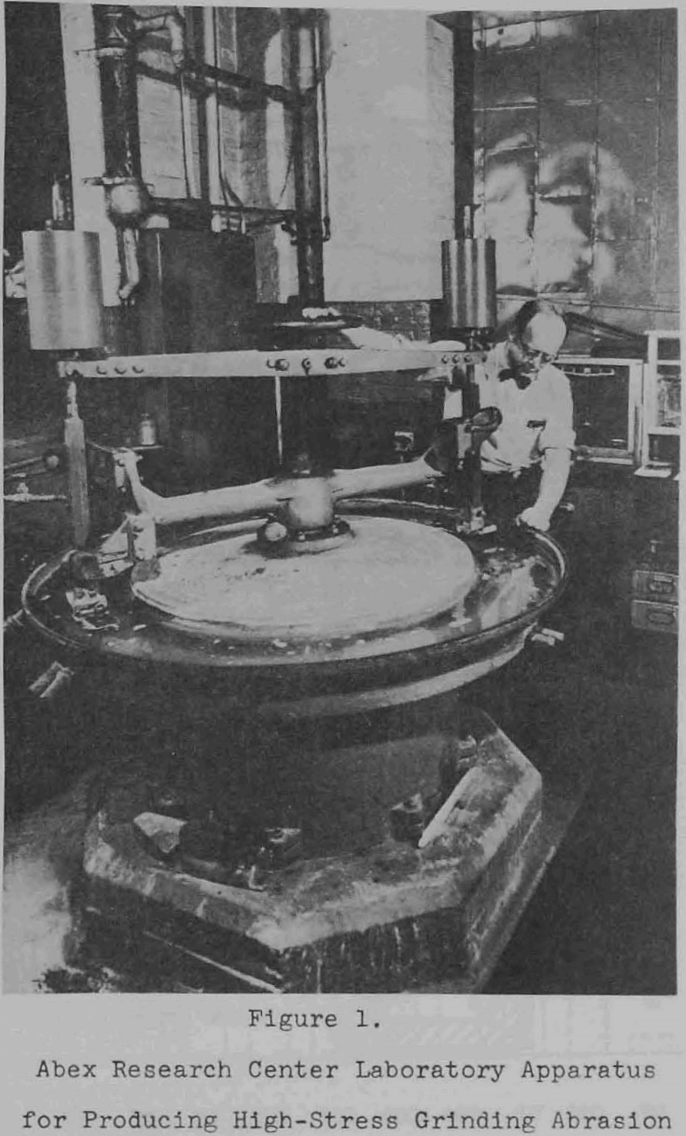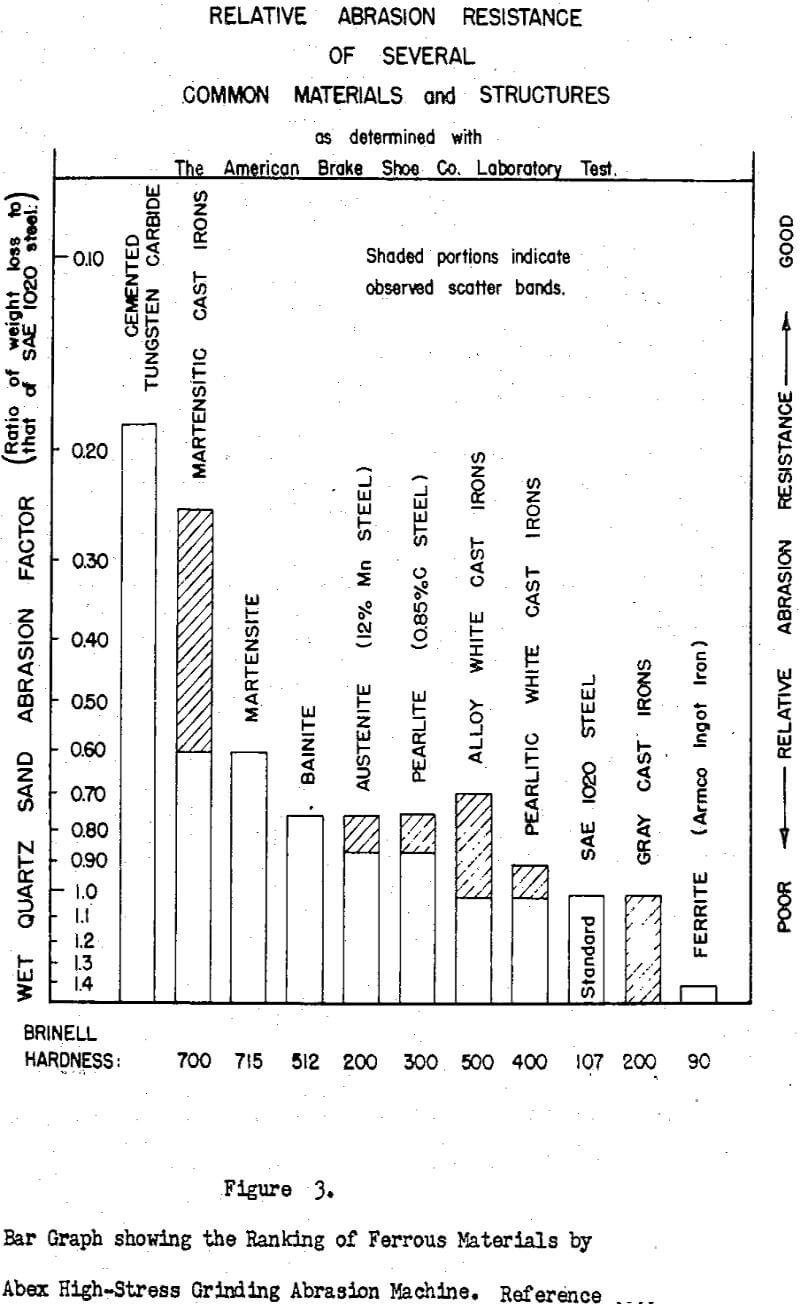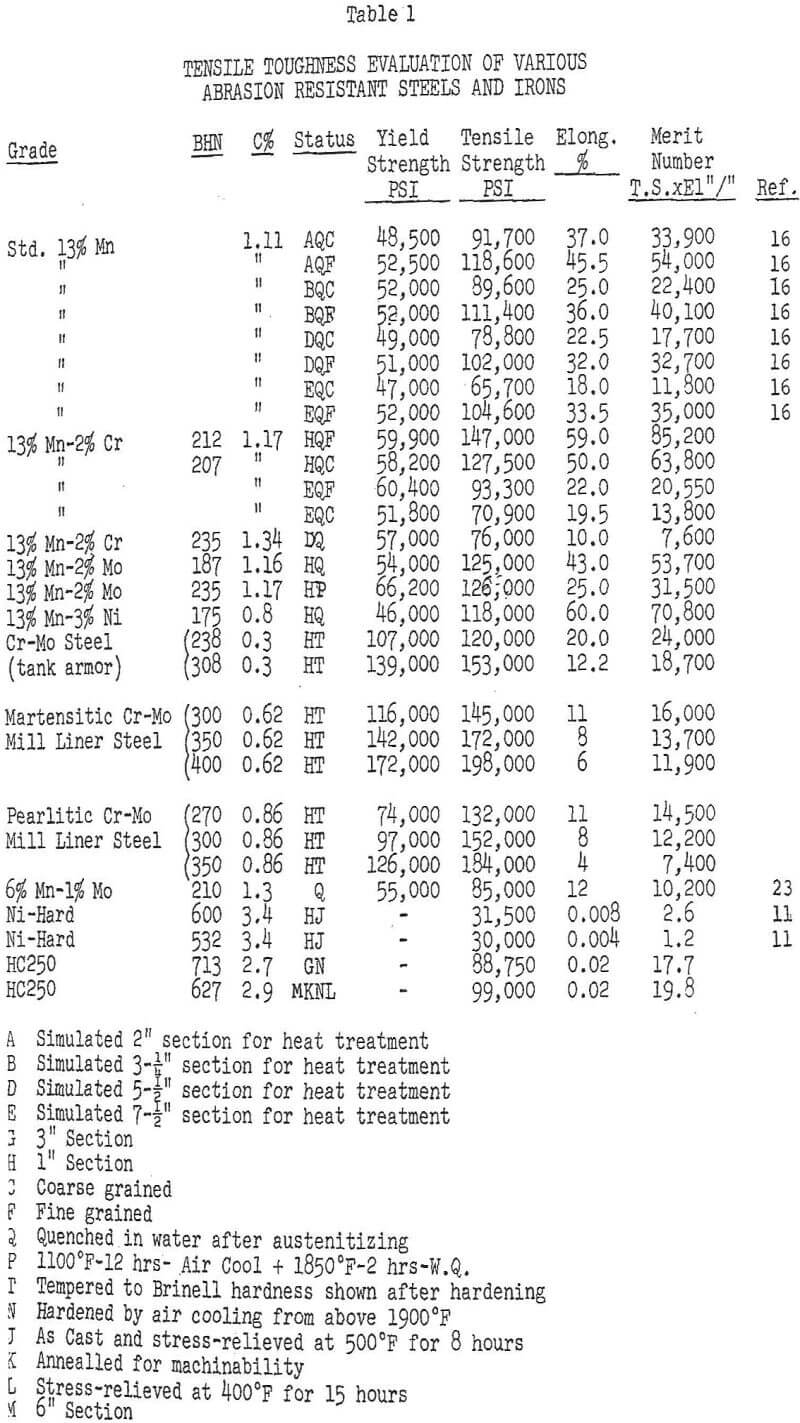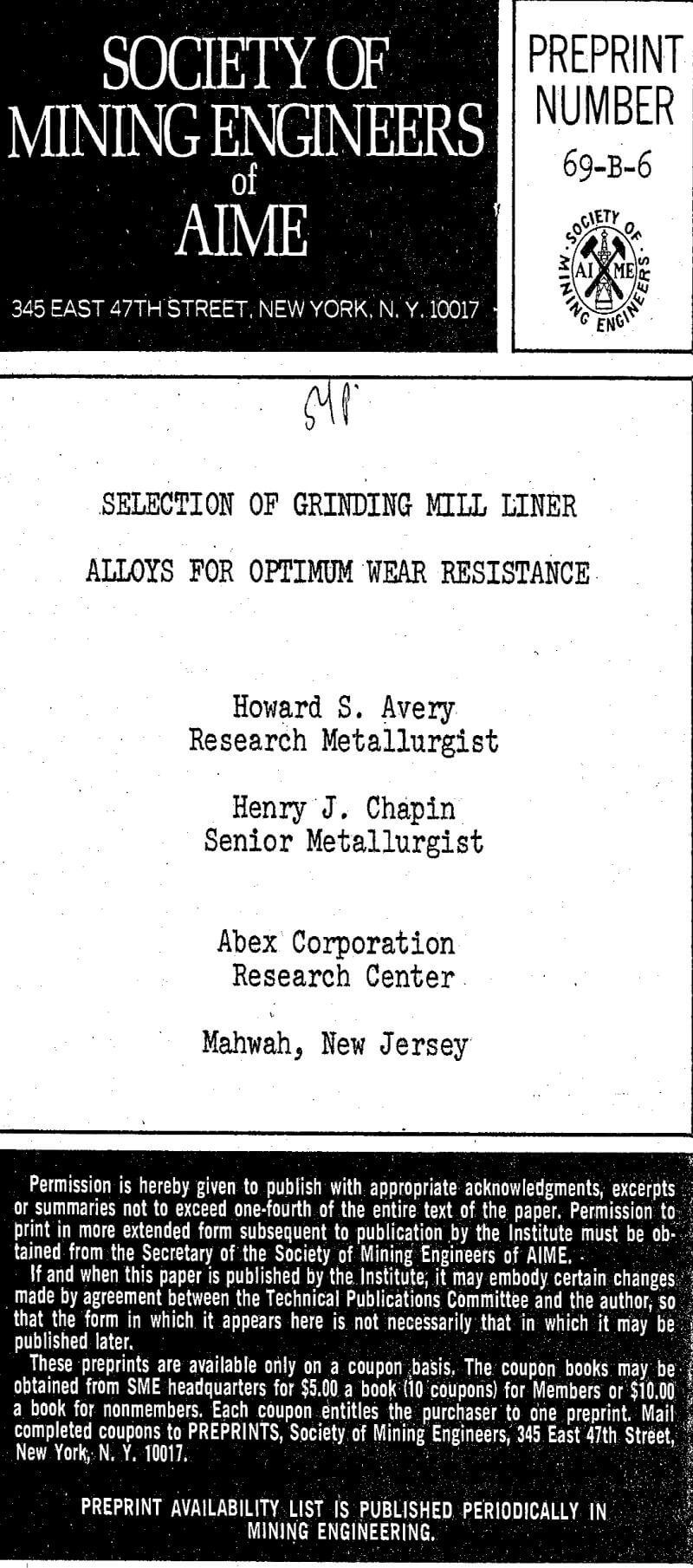Table of Contents
The wear resistance of an alloy in heavy mill liner sections may be quite different from that of the same alloy in small balls and other light sections. This fact was established by means of a well standardized laboratory test that was validated for ball mill service. The salient properties of mill liner alloys, including austenitic manganese steels, medium alloy hardenable steels, and abrasion resistance cast irons are described, critically compared, and quantitatively ranked in terms of mill liner service.
Where they are tough enough the high-chromium and other martensitic cast irons (e.g. Ni-Hard) promise maximum economy, but their section sensitivity is a limitation. To overcome this an extensive research program studied over a hundred experimental alloys, ranking them for heavy section abrasion resistance by means of the laboratory test.
Criteria for Abrasion Resistance
There is a widespread tendency to accept hardness as an index of abrasion resistance. Most hardness tests provide a measure of compressive strength, e.g. the common Brinell test is reported in terms of a Brinell Hardness Number (BHN) that is the compressive strength of the metal tested in kilograms per square millimeter. The numbers can be converted to pounds per square inch if desired. Such values are not representative of tensile strength except in those cases where a ductile material has about the same strength under both types of stress. Hardness tests give no measure of toughness, which makes an important contribution to wear resistance in some circumstances. Hardness also has a poor correlation with resistance to grinding abrasion.
Abrasive wear results from the failure of a material under stress, but the stress patterns imposed in service are so varied and complex that test information in addition to hardness- is desirable. Of the three designated types of abrasion erosion is expected to be present in grinding mills, but it is believed that it makes only a minor contribution to the total wear; gouging abrasion is not considered applicable since it is the type observed in large crushers and in dipper teeth; and grinding abrasion is not only recognizable as present but the matching laboratory test has a demonstrable relation to grinding mill service.
Grinding or high stress abrasion typically results when small mineral particles are caught under pressure between two metal faces. Even with low nominal loads on the metal portion of this sandwich the unit stresses in the abrasive, and consequently on its metallic contact areas, may be very high. These stresses crack or crush the abrasive grains. The broken edges are sharp and can scratch effectively. Moreover, the concentrated stress on the metallic face can disrupt the metal or fragment some of its microconstituents and deterioration can occur from scratching, from local plastic flow and from micro- cracking. The presence of high stress abrasion can be deduced from observation of the metal sandwich described and from the fact that an abrasive is ground or crushed on a small scale.
Criteria for Toughness
At the very tough extreme, where austenitic manganese steel is preeminent, the area under a tensile stress-strain curve (or the more convenient “merit number”) can be used for comparative ranking. This area is an indication of the energy required to deform the material. However, complete stress-strain curves are not usually available; the extensometer that shows strain is generally removed after the yield strength is passed, since it has only a limited range of measurement, and thus only the early part of the curve is obtained.
A rough approximation of the area under the stress-strain curve can be obtained by multiplying the tensile strength (in psi) by the elongation at fracture. This is the “merit number”, which can be conveniently applied to any alloy for which tensile data are available. If due allowance is made for its approximate nature, it is considered a valid measure of toughness for materials where fracture is not complicated by cleavage. It can be applied even to the brittle cast irons, but to do so requires carefully machine ground specimens, almost perfect axial alignment in the tension test, and the use of high precision strain gages, e.g. of the electrical resistance type. Consequently such data for the hard irons are rare.
Compression tests can also show strength and capacity for plastic flow before fracture occurs. They are seldom reported for steels, probably because tension tests are more convenient. For quite ductile materials the values in tension and compression may be quite similar. For brittle alloys like the cast irons they can be vastly different.
Actually we know that both balls and liners of Ni-Hard will spall and fracture in some mills. Discounting those failures that result from poor fit or bolting practice that produces excessive tensile stress on the back side of a poorly supported liner, it can be accepted that Ni-Hard is borderline in toughness for mill liners.
As a result of ball action in a mill,work hardening and high residual compressive stresses occur at the metallic surfaces involved. This implies that the yield strengths have been exceeded, as these phenomena are associated with plastic flow. One aspect of brittleness is the lack of ability to plastically deform under stress. This may be general in a hard metal, the characteristic of a particular phase in an alloy (e.g. the brittle iron carbide in cast iron), or it may be a directional property, perhaps affected by temperature. The crystallographic property of cleavage in some minerals, well known to mining engineers, also occurs in some otherwise ductile metals, especially below a “transition temperature”. Notched bar impact tests tend to show up this kind of brittleness much better than do tension tests. Even ductile materials may show brittle failure with triaxial stresses, which tend to be produced at the root of a notch.
Austenitic Manganese Steels
Austenitic manganese steel, which is also called Hadfield’s manganese steel after its inventor, is an extremely tough non-magnetic alloy in which the usual hardening transformation has been suppressed by a combination of high manganese content and rapid cooling from a high temperature. It is characterized by high strength, high ductility and excellent wear resistance. In the form of castings or of rolled shapes it serves many industrial requirements economically and has built up an enviable record as the outstanding material.for resisting severe service that combines abrasion and heavy impact. It provides the tough extreme of the alloys available for mill liner service.
Some hundreds of other experimental manganese steels have been studied. From these a few have reached commercial production but not general acceptance. Since the full measure of toughness available is almost never needed in mill liners, there is little incentive to choose from among the modified grades unless better abrasion resistance can be demonstrated in grinding mill service.
Some years ago manganese steel liners were more popular than they are now. Originally adopted because of the excellent wear resistance of this steel in other applications, experience revealed that other materials would outwear it in grinding mills. There was reluctance to change until the questions about adequate toughness in the alternate materials could be answered. It is now known that in some mills even brittle cast irons can stand up; in others the irons will chip or fracture under ball impact while some of the steels that are hardened by heat treatment are tough enough. In a few cases manganese steel is still retained because its toughness (which is far beyond that of the hardened mill liner steels) is considered necessary.
Lean Alloy Manganese Steels
If the questionable concept that work hardening contributes to the abrasion resistance of manganese steel is accepted, it is logical to modify this family of alloys to achieve more rapid work hardening. This can be done, but in the field of grinding abrasion the results are likely to be disappointing. The two 8% Mn steels in Table 8 work-harden considerably faster than the standard grade; indeed they become somewhat magnetic from the deformation that causes the work-hardening, suggesting that the martensitic reaction, often postulated but not proven for the standard 13% Mn grade, is actually occurring. In this case the abrasion resistance is clearly inferior to that of the more stable 13% Mn type. The two 8% Mn steels also lack toughness.
Lowering of either carbon or manganese tends to degrade the properties for which the 13% manganese steels are valued. However, it is possible to counteract this degradation by adding other elements. Such compensation is practiced, chiefly in the field of welding electrodes. Most of these invoke this pattern.
Abrasion Resistant Cast Irons
The earliest cast irons used in grinding mill service were simple pearlitic white irons; that is, the composition was adjusted or the castings were chilled in manufacture to produce a mixture of cementite (iron carbide) and pearlite (the lamellar aggregate of cementite and ferrite that is a common constituent of slowly cooled medium and high carbon steels). Slowly solidified cast iron that is high in silicon will have much of its carbon appear as graphite flakes; these are considered undesirable for abrasion resistance and are suppressed by control of the silicon, perhaps by additions of chromium and by means of chills in the mold.
White (graphite free) cast iron has good resistance to low-stress scratching abrasion or erosion, but it has been disappointing in grinding mills. The Abex test provides abrasion factors that are generally between 0.90 and 1.00, indicating that it is very little better for resisting grinding abrasion than soft mild steel. It required some years of experience for this to become well recognized in service, but now a simple white cast iron is seldom considered for mill liners.
Irons alloyed to produce martensite instead of pearlite in the microstructure are a different matter. Following the introduction of Ni-Hard (U.S. Patent 1,988,911 issued in 1935) it became evident that this type (Table 12) had better abrasion resistance than the ordinary white cast iron under a variety of conditions. Wot only for low-stress abrasion but also under the high stress conditions of ball mills it could show superiority. With its excellent potential for resisting wear the matter of toughness became, crucial. Its performance in grinding mills would depend on whether it chipped, thus adding a second deterioration mechanism to that of abrasive wear, and on whether there would be gross breakage under mill impact conditions. Pear of the latter retarded its acceptance as a liner material. It was accepted first for balls.
Field Tests
Promising alloys have been previously introduced into mill liner service only to find that for some reason they cannot compete with existing materials. Unless they cost too much their deficiency has usually been in either toughness or abrasion resistance. The 19% chromium iron aimed at the apex of one of the computer parabolas is now in the field testing stage. To reach this point has required considerable pilot plant and production effort, as processing details and quality controls had to be worked out on a full scale basis. Also, a full set of liner castings is necessarily expensive and thus the initial tests had to be introduced on a guaranteed performance basis. The field testing is still in progress but results have been favorable. Two tests can be reported at this point.
One test was made in a 12′ – 2″ diameter x 14′ long Nordberg rod mill with medium height overflow discharge and Noranda type shell liners. The grinding media are 4 – 3/8 inch diameter rods of 1090 steel at about 269 – 311 Brinell hardness. Mill speed is 13.3 rpm, which is about 59% of the theoretical critical speed. The feed is 1 inch size and the product is about ¼ inch; the pulp density at discharge is about 75%. The production rate is 110 long tons per hour or 3000 short tons per day. The ore being ground is taconite. The ore mineral is magnetite, which itself is quite hard, but the abrasiveness of the ore is attributed largely to quartz and hard silicates that are so well interlocked that the material is very tough, with an average compressive strength of around 55,000 psi.





